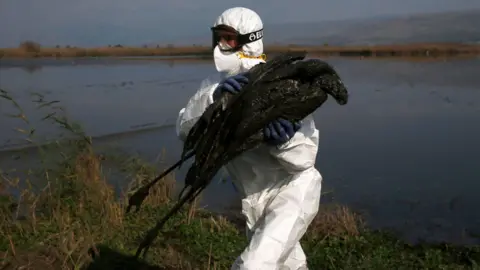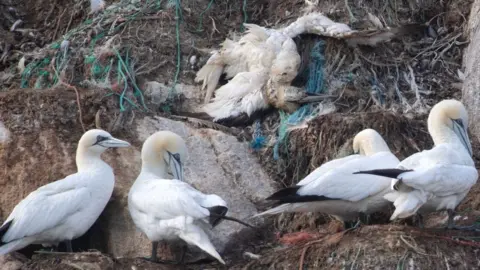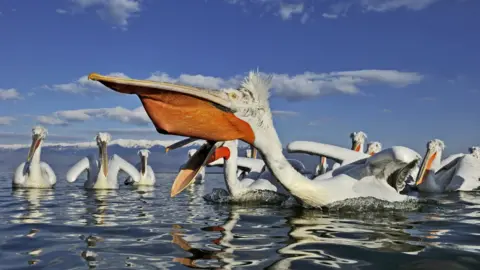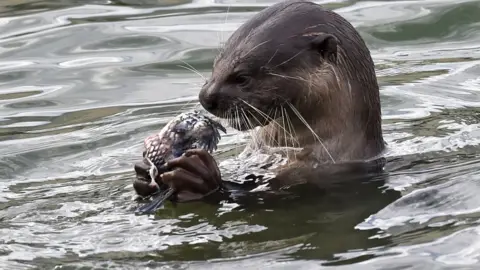

Bird flu is a disease caused by a virus that infects birds and sometimes other animals, such as foxes, seals and otters.
The major strain – circulating among wild birds worldwide – is a type of the virus known as H5N1. It emerged in China in the late 1990s.
Bird migration has led to outbreaks in domestic and wild birds. The virus has in very rare cases infected humans.
Scientists say the current risk to humans is low. Transmission from birds to humans is rare and there has been no sustained human-to-human transmission.
There is no way to predict whether avian flu will trigger a pandemic in humans, but experts are monitoring its spread and studying how it is changing and evolving.

H5N1 is now spreading rapidly in dairy cow herds in the US in what the US Centres for Disease Control, CDC, describes as an “ongoing multi-state outbreak”.
The virus’s jump into cattle astounded scientists, who thought cows weren’t susceptible to it.
It comes amid another unusual development: In early June, a 59-year-old man in Mexico died with another type of bird flu – H5N2 – which had never before been recorded in people. It is unclear how he got it, although there have been cases in some poultry farms in Mexico.
Health bodies such as the World Health Organization and the CDC consider the overall public health risk from bird flu to be low. But scientists say we need to keep a close eye on the spread of the virus.
“This case is one more in a series of developments that collectively could be considered a red flag,” says Professor Sir Peter Horby, director of the Pandemic Sciences Institute at the University of Oxford.
H5N1 has been on scientists’ radar for the past few years, with the virus spreading across all continents. Thousands of outbreaks have been recorded in poultry and wild birds.
There have been outbreaks in animals farmed for their fur, including mink.
In late 2023 in Peru, more than 5,000 sea lions died with the virus, which scientists say was caused by the animals’ direct contact with infected wild birds.
The virus has also been detected in foxes, bears, otters, raccoons, cats, dogs, goats and others.
“It’s a virus that’s on the march so we’ve been watching it with concern for that reason,” says Dr Ed Hutchinson, Senior Lecturer, MRC-University of Glasgow Centre for Virus Research.

Flu viruses are known for their ability to shape-shift, picking up genes and changing over time as they move outside their natural host.
Scientists are watching closely for signs H5N1 might gain a sustained foothold outside poultry and wild birds.
Finding the virus in cattle was “a real shock”, says Dr Hutchinson.
“When it turns up in an animal where large numbers of them are farmed and therefore in close proximity with humans that immediately is a reason for paying close attention to it.”
Scientists think the route of transmission is what they call “artificial” – the cows are not passing it to one another through natural contact and it probably isn’t transmitting in airborne particles from cow to cow.
Instead, they think all the transmission is happening in milking parlours. “It looks like it’s through contaminated milking machinery,” explains Dr Thomas Peacock from the Pirbright Institute.
This means that the virus, at the moment, doesn’t have the ability to spread naturally from animal to animal. The longer it does go on spreading through dairy herds though, Dr Peacock says, the higher the chance that it evolves in a way that would allow it to do that.
Pasteurisation is understood to destroy the virus, but it’s estimated that about 5% of Americans consume raw, unpasteurised milk.
Across the border in Canada, scientists have also begun testing milk.
There have been cases of humans catching H5N1 from time to time, usually from contact with sick animals, in several countries, including Cambodia, Chile, China, Vietnam, Australia, USA and the UK.
A few hundred human cases have been reported since 1997, around half of whom died.

More recently, there have been a few cases in US dairy workers, who had only mild symptoms.
Many US states are investing in preventative measures, like protective clothing and goggles for farm workers.
Experts studying the virus say there’s no evidence it has morphed into a form that would pose a big threat to humans.
But as two eminent flu experts warned in an article in the British Medical Journal: “the hazard and risk of a major outbreak of H5N1 are large, plausible and imminent.”
Virologist Tom Peacock says the more that it spreads across the US, the higher the chance that the virus gets into humans.
And, importantly, the higher the chance that it gets into waterfowl – ducks and geese.
“That’s what we’re worried about,” he tells the BBC. “Because [those birds] are the ones that one are very susceptible to this, and they seem to be the ones that carry it very large distances.
Some countries are discussing deploying vaccines or are working to secure supplies.
But with only limited supplies available, any vaccine campaign would be limited, with doses distributed to front line workers including poultry farmers, veterinarians, scientists who study the virus, and people who work on fur farms housing animals like mink and fox.

Dr Jayna Raghwani, a biologist from the UK’s Royal Veterinary College, points out that, in terms of designing new avian flu vaccines, we are relatively well prepared.
“We don’t have to start from scratch with an influenza virus,” she says. “And we have a good understanding of how those [existing flu vaccines] work in order to raise an immune response and be protective.
“In an ideal world,” she adds, there would be more surveillance for the virus close to farms.
“We could do more general monitoring of wildlife close to places we know outbreaks are occurring and more in domestic animals,” Dr Raghwani says, “to better understand how the virus changes between species.”
“I don’t want to downplay concerns about the influenza [circulating in cows],” says Dr Raghwani. “But if I was talking to my mum or my grandma about the risk to humans, I would say ‘don’t worry’.”
Dr Hutchinson puts it this way: “It’s not February 2020 but it does demand our close attention. There are definite risks associated with this and they might not go anywhere but we’d be very foolish not to pay attention to them.” – bbc.com